仁爱版英语八年级上Unit1Topic3SectionA教案设计
仁爱版八年级英语上册全册教学设计全套教案
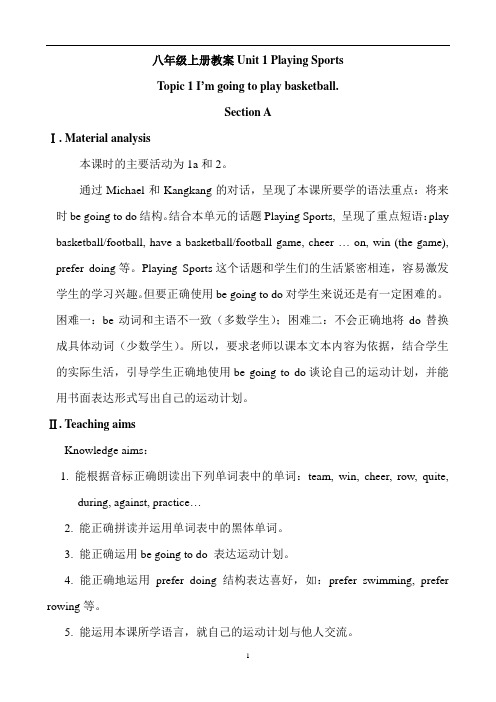
八年级上册教案Unit 1 Playing SportsTopic 1 I’m going to play basketball.Section AⅠ. Material analysis本课时的主要活动为1a和2。
通过Michael和Kangkang的对话,呈现了本课所要学的语法重点:将来时be going to do结构。
结合本单元的话题Playing Sports, 呈现了重点短语:play basketball/football, have a basketball/football game, cheer … on, win (the game), prefer doing等。
Playing Sports这个话题和学生们的生活紧密相连,容易激发学生的学习兴趣。
但要正确使用be going to do对学生来说还是有一定困难的。
困难一:be动词和主语不一致(多数学生);困难二:不会正确地将do替换成具体动词(少数学生)。
所以,要求老师以课本文本内容为依据,结合学生的实际生活,引导学生正确地使用be going to do谈论自己的运动计划,并能用书面表达形式写出自己的运动计划。
Ⅱ. Teaching aimsKnowledge aims:1. 能根据音标正确朗读出下列单词表中的单词:team, win, cheer, row, quite,during, against, practice…2. 能正确拼读并运用单词表中的黑体单词。
3. 能正确运用be going to do 表达运动计划。
4. 能正确地运用prefer doing结构表达喜好,如:prefer swimming, prefer rowing等。
5. 能运用本课所学语言,就自己的运动计划与他人交流。
Skill aims:1. 能听懂有关运动计划和运动爱好的简单对话和陈述。
2. 能正确地口头表达有关运动计划和运动爱好的话题。
仁爱英语八年级上Unit1Topic3Section A教案

Topic 3 Which sport will you take part in?Section AThe main activities are 1a and 2a. 本课重点活动是1a和2a。
Ⅰ.Teaching aims and demands 教学目标1.Learn some new words and phrases:foreign, have fun, lots of, be ready for, relay race, maybe, make friends, perhaps2.Learn the future tense with will:(1)I think I will have lots of fun.(2)I will do my best. I won’t lose.(3)Maybe I will make many friends during the sports meet.(4)I’ll join in the teachers’ relay race.3.Talk about school sports meet:(1)I will take part in the school sports meet.(2)Which sport will you take part in?(3)I’ll be in the long jump and the high jump.(4)I’m sure our school sports meet will be exciting.Ⅱ. Teaching aids 教具录音机/幻灯片Ⅲ. Five-finger Teaching Plan 五指教学方案Step 1 Review 第一步复习(时间:8分钟)复习上个话题的语法、句型及功能用语,引出本课生词、语法及话题,导入新课。
1. (让学生进行链式问答,复习上一话题的重要语法和功能用语。
仁爱英语八年级上册Unit3,Topic1,SectionA公开课教案
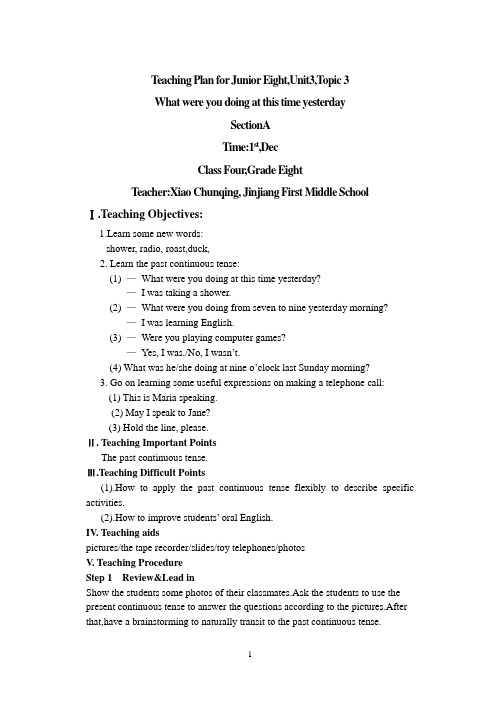
T eaching Plan for Junior Eight,Unit3,T opic 3What were you doing at this time yesterdaySectionATime:1st,DecClass Four,Grade EightT eacher:Xiao Chunqing, Jinjiang First Middle SchoolⅠ.Teaching Objectives:1.Learn some new words:shower, radio, roast,duck,2. Learn the past continuous tense:(1) —What were you doing at this time yesterday?—I was taking a shower.(2) —What were you doing from seven to nine yesterday morning?—I was learning English.(3) —Were you playing computer games?—Yes, I was./No, I wasn’t.(4) What was he/she doing at nine o’clock last Sunday morning?3. Go on learning some useful expressions on making a telephone call:(1) This is Maria speaking.(2) May I speak to Jane?(3) Hold the line, please.Ⅱ. Teaching Important PointsThe past continuous tense.Ⅲ.Teaching Difficult Points(1).How to apply the past continuous tense flexibly to describe specific activities.(2).How to improve students’ oral English.IV. Teaching aidspictures/the tape recorder/slides/toy telephones/photosV. Teaching ProcedureStep 1 Review&Lead inShow the students some photos of their classmates.Ask the students to use the present continuous tense to answer the questions according to the pictures.After that,have a brainstorming to naturally transit to the past continuous tense.Step 2 Presentation1.Listen to the tape and answer the questions.2. Read after the tape,fill in the blanks and underline the important words,phrases and sentences.3. Give the students some minutes to read the dialogue by themselves and ask some students to act out the dialogue in pairs.Step 3 PracticeA guessing game.Ask the students to use their imagination to guess what was he/she doing in the pictures.Step 4 ConsolidationAsk and answer in pairs after the example.Step 5 SummaryLead the students to have a quick looking back on the teaching content in this period.Step 6 HomeworkMake a survey about your group members 'activities at different times last Sunday morning.Talk about it with your group members to find who has spent the most interesting Sunday and then report it to your class.Time What were you doing?7:00—8:00 a.m.8:00—9:00 a.m.9:00—10:00 a.m.10:00—11:00 p.m.Section BThe main activities are 1a, 1c and 2a. 本课重点活动是1a, 1c 和2a. Ⅰ.Teaching aims and demands 教学目标 1. Learn some new words and useful phrases:agree, pleasant, agree with sb., handsome, useful, sad, make faces, laugh 2. Learn some useful sentences: (1)I thought it was just so-so. (2)I thought he was very brave! (3)It ’s nothing serious.(4)Miss Wang was angry with me.3. Go on learning the past continuous tense:(1)—What were you doing at this time last night? —I was watching a Harry Potter movie.(2)Because I made faces and made my classmates laugh when she was giving us a lesson.(3)You weren ’t listening to the teacher.4. Learn to express agreement and disagreement: —I think classical music is pleasant. I agree with you. / Yes, I think so. I don ’t agree. / No, I don ’t think so. I think it ’s boring. Ⅱ. Teaching aids 教具—挂图/课件/录音机/小黑板/卡片Ⅲ. Five-finger Teaching Plan 五指教学方案Step 1 Review 第一步复习(时间:6分钟)通过创设情景,表演对话复习过去进行时,导入新课。
仁爱版八年级上册Unit3Topic1What’syourhobbySectionA优秀教学案例

三、教学策略
(一)情景创设
1.教师通过展示不同兴趣爱好相关的图片、视频等多媒体资源,引导学生进入学习情境,激发学生对主题的兴趣。
2.教师设计真实的交流场景,如模拟面试、角色扮演等,让学生在具体情境中运用所学知识,提高交际能力。
仁爱版八年级上册Unit3Topic1What’syourhobbySectionA优秀教学案例
一、案例背景
本案例背景以仁爱版八年级上册Unit3Topic1What’syourhobbySectionA为基础,探讨如何通过课堂教学,培养学生的兴趣爱好,提高他们的英语听说读写能力,以及合作和创新精神。本节课的主要内容是介绍个人的兴趣爱好,通过询问和回答问题,学生能够熟练运用本课核心句型进行交流,提高他们的语言表达能力。同时,通过小组合作完成任务,培养学生的团队协作能力和创新思维。在教学过程中,教师应以学生为中心,关注学生的个体差异,创设真实、有趣的学习情境,激发学生的学习兴趣,帮助他们掌握所学知识。
(四)总结归纳
1.教师引导学生回顾本节课所学的知识和技能,帮助他们进行知识梳理和归纳。
2.教师通过提问和总结,强调本节课的重点和难点,确保学生能够理解和掌握。
3.教师给出本节课的课堂作业,让学生巩固所学知识,提高实际应用能力。
(五)作业小结
1.教师提醒学生按时完成作业,并强调作业的重要性,培养学生的自律和责任感。
3.教师鼓励学生提出问题,培养学生的批判性思维和独立思考能力,使学生在探究过程中不断成长。
(三)小组合作
1.教师将学生分成小组,根据小组特点和能力,分配不同难度的任务,使学生在合作中互补、共进。
2.教师指导学生明确分工,鼓励学生发挥各自优势,培养学生团队协作能力和责任意识。
仁爱版八年级英语上册精品教学案U3T1SC
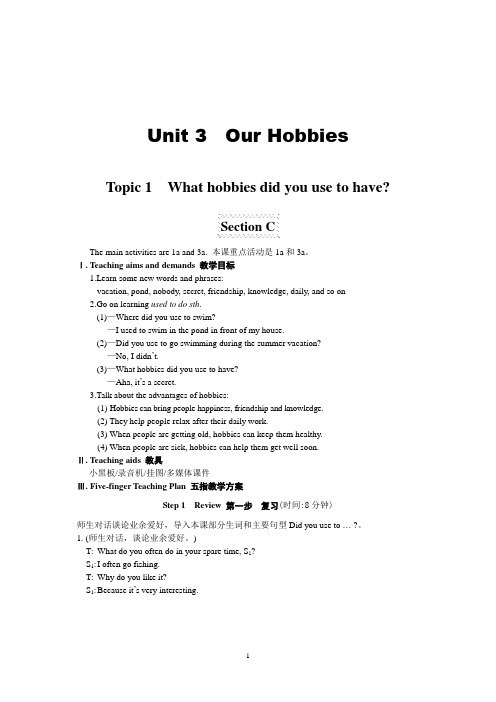
Unit 3 Our Hobbies Topic 1 What hobbies did you use to have?Section CThe main activities are 1a and 3a. 本课重点活动是1a和3a。
Ⅰ. Teaching aims and demands 教学目标1.Learn some new words and phrases:vacation, pond, nobody, secret, friendship, knowledge, daily, and so on2.Go on learning used to do sth.(1)—Where did you use to swim?—I used to swim in the pond in front of my house.(2)—Did you use to go swimming during the summer vacation?—No, I didn’t.(3)—What hobbies did you use to have?—Aha, it’s a secret.3.Talk about the advantages of hobbies:(1) Hobbies can bring people happiness, friendship and knowledge.(2) They help people relax after their daily work.(3) When people are getting old, hobbies can keep them healthy.(4) When people are sick, hobbies can help them get well soon.Ⅱ. Teaching aids 教具小黑板/录音机/挂图/多媒体课件Ⅲ. Five-finger Teaching Plan 五指教学方案Step 1 Review 第一步复习(时间:8分钟)师生对话谈论业余爱好,导入本课部分生词和主要句型Did you use to … ?。
2021年仁爱版初中八年级英语上册全册教案
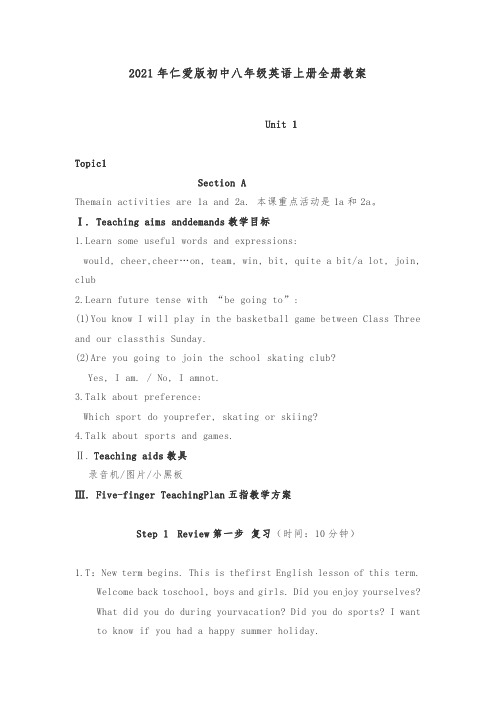
2021年仁爱版初中八年级英语上册全册教案Unit1Topic1Section AThemain activities are1a and2a.本课重点活动是1a和2a。
Ⅰ.Teaching aims anddemands教学目标1.Learn some useful words and expressions:would,cheer,cheer…on,team,win,bit,quite a bit/a lot,join, club2.Learn future tense with“be going to”:(1)You know I will play in the basketball game between Class Three and our classthis Sunday.(2)Are you going to join the school skating club?Yes,I am./No,I amnot.3.Talk about preference:Which sport do youprefer,skating or skiing?4.Talk about sports and games.Ⅱ.Teaching aids教具录音机/图片/小黑板Ⅲ.Five-finger TeachingPlan五指教学方案Step1Review第一步复习(时间:10分钟)1.T:New term begins.This is thefirst English lesson of this term.Welcome back toschool,boys and girls.Did you enjoy yourselves?What did you do during yourvacation?Did you do sports?I want to know if you had a happy summer holiday.Ss:…T:Which sport did youdo?S1,please.S1:I played…in thesummer holiday.T:Which sport do youlike best?S1:I like…best.T:We all know sportsare good for our health.Now let’sreview some sports we learned before.2.(教师展示一些关于运动的图片,复习学过的运动项目名称。
仁爱版八年级英语上册Unit3Topic1SectionA教学设计

1.教师给出讨论话题,如:“What do you want to do in the future?”,让学生分组进行讨论。
2.学生在小组内运用本节课所学的词汇和语法,分享自己的未来计划,同时倾听他人的想法。
3.各小组选代表进行汇报,其他小组成员给予评价和反馈。
(四)课堂练习
1.教师设计不同类型的练习题,如填空、选择、改错等,让学生巩固所学知识。
5.家庭互动:鼓励学生与家人分享本节课所学内容,让家人参与讨论,共同完成一份关于家庭未来计划的短文。
6.预习作业:布置下一课时的预习任务,要求学生提前了解下节课的主题,预习相关词汇和语法,为课堂学习做好准备。
教师应在学生提交作业后,及时给予评价和反馈,鼓励学生发挥潜能,不断提高英语水平。同时,关注学生在作业中的表现,了解学生的学习需求,为下一节课的教学做好准备。
4.树立自信心,勇于表达自己的观点和需求,敢于面对挑战,克服困难。
二、学情分析
八年级学生经过前一阶段的学习,已经具备了一定的英语基础,包括词汇量、语法知识和听说读写技能。在此基础上,针对本章节的学习,学情分析如下:
1.学生在上一单元学习了描述人物特征、兴趣爱好等话题,为本章节讨论日常生活、工作和学习中的需求、喜好等打下良好基础。
2.安排口语练习,如角色扮演、小组讨论等,让学生在实际语境中运用所学词汇和语法。
3.针对不同学生的学习需求,提供分层练习,使每位学生都能在练习中找到适合自己的难度。
(五)总结归纳
1.教师引导学生总结本节课所学的词汇、语法和句型,巩固知识。
2.学生分享自己在课堂上的收获和感悟,提高课堂参与度。
3.教师对学生的表现给予评价和鼓励,强调学习英语的重要性,激发学生的学习动力。
仁爱版八年级英语上Unit3Topic1SectionA教学设计

3、情感态度与价值观
1)、能够与同伴积极合作,参与课堂活动,大胆实践,共同完成学习任务。
2)、能形成广泛的兴趣爱好,活泼开朗的个性和对生活、未来的积极态度。
3)、学生在宽松活泼的课堂气氛中,始终保持着浓厚的学习兴趣,体会到学习英语与使用英语的成就感和乐趣,增强自信心。
5)、能在教师的指导下实行简单的采访活动并形成书面表达。
2、过程与方法
1)、学生积极主动参与各项课堂活动,利用观察、发现、分析、归纳等方法理解语言规律,边学边用,活学活用。
2)、学生采用自主学习和小组合作学习的方法并与小组合作伙伴使用角色扮演的方法熟练掌握课文对话。
3)、通过师生对话、两两对话、小组交流等形式让学生体验交际性英语教学过程,掌握英语听说的基本方法,体验合作学习的快乐。
2)、初始水平:此前学生已完成七年级上、下册以及八年级第一、二单元的系统学习。学生已有过学习、体会合作学习的经历,具有良好的合作意识和团队精神。喜欢游戏、比赛等多种刺激同时作用的学习方式。但是初二学生两极分化现象凸显,学习水平也参差不齐。
3)、信息素养:初二学生已经有了一定的信息素养,能够从书本、电视、网络等多种渠道获取信息,但信息的加工、提取、使用的水平还较弱。他们对感兴趣的事物有较强的获取信息的欲望。
number the pictures.
Check the answers
5. Lead the Ss to
read and master the
new phrases.
1. Think and guess
the meanings of new
phrasesaccording to
仁爱版英语八年级上册Unit3topic1sectionA教学设计

1.教师引导学生总结本节课所学的重点知识,如一般现在时态的用法、新词汇和短语、重点句型等。
2.让学生分享在本节课中的收获和感悟,以及对未来学习的期望。
3.教师针对学生的总结进行补充和归纳,强调本节课的重点和难点,为课后复习和巩固提供指导。
五、作业布置
为了巩固本节课的学习成果,培养学生的自主学习能力,特布置以下作业:
-小组讨论:将学生分成小组,讨论并分享个人的日常活动,促使他们在实际语境中运用一般现在时态。
-角色扮演:设计情景剧,让学生扮演不同角色,通过角色扮演加深对重点词汇和句型的记忆。
-听力练习:播放与本节课话题相关的听力材料,让学生在听的过程中获取关键信息,提高听力理解能力。
2.创设真实语境,让学生在实践中突破难点。
4.利用多媒体教学资源,提高学生的学习兴趣和参与度。
-图片和视频:展示与话题相关的图片和视频,激发学生的学习兴趣,增强课堂教学的趣味性。
-互动游戏:设计互动游戏,让学生在游戏中巩固所学知识,提高学习效果。
5.加强课后跟踪评价,了解学生的学习效果,及时调整教学策略。
-课后作业:布置与课堂内容相关的作业,巩固学生对重点知识的掌握。
-家长与孩子共同完成一份关于家庭活动的英文海报,鼓励孩子运用所学知识,提高英语实际运用能力。
5.预习作业:
-预习下一课的内容,提前了解新词汇和短语,为新课的学习做好准备。
-尝试总结一般现在时态的用法,为新课的学习打下基础。
2.学会使用一般现在时态描述个人的日常活动和习惯,如:“I go to school by bus every day.”
3.能够理解和运用本课中的重点句型,如:“What do you usually do in the morning?”, “I usually have breakfast and read English.”
仁爱版八年级英语上Unit3Topic1SectionA教学设计

5.培养学生通过查阅资料、同伴互助等方式,获取与兴趣爱好相关的文化背景知识。
(二)过程与方法
在本章节的教学过程中,教师将采用以下方法引导学生学习:
1.情境教学法:通过创设真实的语境,让学生在实际交流中学习和运用目标语言。
2.任务型教学法:设计各种听说活动,如小组讨论、角色扮演、采访等,激发学生的学习兴趣,培养合作精神。
-设计不同难度的听说活动,如小组讨论、角色扮演、采访等,满足不同水平学生的需求。
-采用任务型教学法,引导学生通过完成具体的任务,达到巩固和提高语言能力的目的。
2.教学步骤设想:
(1)导入:通过展示一组关于兴趣爱好的图片,引导学生进行头脑风暴,激发他们的学习兴趣。
(2)新课内容展示:呈现Unit3 Topic1 Section A的听力材料,引导学生关注一般现在时态的用法,学习描述兴趣爱好的相关词汇和句型。
三、教学重难点和教学设想
(一)教学重难点
1.重点:本节课的重点在于学生能够运用一般现在时态描述兴趣爱好,掌握相关的词汇和句型,如:“What do you like to do?”, “I like to collect…”, “It's…to…”, “I think…is…”, “Why do you like…?”等。
(3)教师巡回指导,关注学生的语言运用,给予及时反馈。
(四)课堂练习
1.教学活动设计
本环节将设计不同形式的练习题,帮助学生巩固所学知识,提高运用能力。
2.教学实施
(1)设计填空、选择、改错等练习题,让学生完成。
(2)组织学生进行角色扮演,模拟真实场景,运用所学知识进行交流。
(3)针对学生的完成情况,给予评价和指导。
初中-英语-仁爱版-八年级上册-Unit1 Topic3 教案

优质资料---欢迎下载Unit 1 Topic 3 Section A 本课是为仁爱英语八年级上学期Unit 1 Topic 3 Section A 编写的教学。
这是第一单元第三课题的第一课时。
在复习了前两个话题——运动类话题的基础上,进一步围绕校运动会展开讨论和学习。
本课从学生实际出发,对教材进行了必要的调整。
为了在45分钟内更好更有效地实现教学目标,设计了直观生动的教学,把教学顺序安排为:一、引——通过两个人的对话,引出本课的谈论话题校运会,学习本课的新词组。
二、学——①通过图片,学习校运会中出现的比赛项目。
②听录音1a,回答问题。
初步了解对话内容。
③观看视频1a,跟读课文,掌握对话内容,根据对话内容填空。
三、探——①知识点讲解。
②根据提示,复述对话内容,让学生加深对课文的记忆。
③阅读采访的内容,根据内容,选择合适的图片。
四、点—— ①听录音3-A ,选择正确答案,训练学生对参加校运会的表达。
②听录音3-B ,完成文章填空。
五、练—— ①假设你是记者,采访一位参加校运会的同学将采访编写成对话形式,并进行对话表演。
②4人小组讨论运动会所要参加的项目,完成表格,并请一个同学来做总结。
六、结 —— 总结本课重点语言点:学习了用 will 来表达一般将来时和谈论运动会。
sentencesvocabularygrammar1.Which sport will you takepart in?2.The boys ’800-meter race.3.I hope so.U3T3SA Future Tense with will/shallexcitingrelay race take part in,be good atU1SAHomework:1.仿照1a,与同学讨论在校运会中你将参加哪个项目?并把这个对话写在作业本上2.完成练习册Section A。
3.背诵1a。
Unit 1 Topic 3 Section B 本课是为仁爱英语八年级上学期Unit 1 Topic 3 Section B 编写的教学内容。
仁爱版八年级英语上册Unit1Topic3SectionA优质教案

八年级上册教案设计Unit1PlayingSportsTopic3Theschoolsportsmeetiscoming.SectionAⅠ.Materialanalysis本节课的主要活动为1a和2b。
SectionA对话里,YuTing和LiMing兴奋地谈论即将到来的运动会,呈现了本课所要学的语法重点FutureTensewithwill。
YuTing和LiMing饶有兴趣地围绕Whichsportwillyoutakepartin?谈论着各自参加的运动会项目,呈现了重点短语:theboys’800-meterrace,beinthelongjump等。
本对话呈现了孩子们积极上进的学习生活,要求学生在学会课本语言知识的同时,向YuTing和LiMing学习,积极参与学校各项集体活动,在培养集体主义思想的同时,培养自己自信、上进的个人素质。
Ⅱ.TeachingaimsKnowledgeaims:1.能正确运用以下短语进行书面表达:theboys’800-meterrace,beinthelongjump,havelotsof fun,preparefor,makemanyfiends,makefriendswithsb.等。
2.能正确地理解下列句子和短语:Theschoolsportsmeetiscoming.thecomingschoolsportsmeet3.能正确理解并运用will将来时,能运用will进行造句。
Skillaims:1.能听懂有关运动会项目的名称及相关话题。
2.能熟练地运用will引导的将来时谈论有关运动会的话题。
3.能正确朗读介绍运动会项目的对话或文章。
4.能用will将来时介绍自己或朋友在运动会中参加的项目。
Emotionalaims:通过学习YuTing和LiMing积极上进的对话内容,鼓励学生要积极参与学校集体活动,培养自己乐观、自信、乐于合作的优良品质。
Ⅲ.ThekeypointsanddifficultpointsKeypoints:theboys’800-meterrace,beinthelongjump,havelotsoffun ,preparefor,makemanyfriends,makefriendswithsb.等短语的理解及运用。
仁爱版英语八年级上册Unit3topic1sectionA优秀教学案例

在课堂导入环节,我利用多媒体展示不同天气图片,引导学生用英语描述所看到的天气状况,从而激发学生的学习兴趣。在课堂活动环节,我设计了一个角色扮演活动,让学生分组进行天气播报,培养他们的合作能力和交际能力。在巩固环节,我通过设计一个天气问答游戏,让学生在轻松愉快的氛围中巩固所学知识。
2.学生能够理解并运用目标句型“What's the weather like?”, “It's...”来询问和描述天气状况。
3.学生能够通过听、说、读、写的实践,提高自己的英语语言运用能力。
4.学生能够学会如何用英语进行简单的天气报道,提高自己的观察图片、听录音、观看视频等多样化的教学手段,引导学生主动探索和学习天气相关的英语知识。
四、教学内容与过程
(一)导入新课
1.利用多媒体展示一张天气预报的图片,引导学生关注天气话题。
2.提出问题:“你们知道现在我国的天气情况吗?”让学生进行思考和讨论。
3.教师分享一则有趣的天气故事,引发学生对天气的兴趣,为新课的展开做好铺垫。
4.正式引入本节课的主题:“仁爱版英语八年级上册Unit3topic1sectionA——weather”。
2.利用小组讨论、角色扮演等互动性强的教学活动,激发学生的参与热情,培养学生合作学习和独立思考的能力。
3.通过设计循序渐进的练习题,帮助学生巩固所学知识,提高学生的实际应用能力。
4.利用多媒体技术,创造一个生动、真实的语言环境,增强学生对英语学习的兴趣。
(三)情感态度与价值观
新仁爱版八年级上册英语Unit 1 Topic 3 整个话题导学案
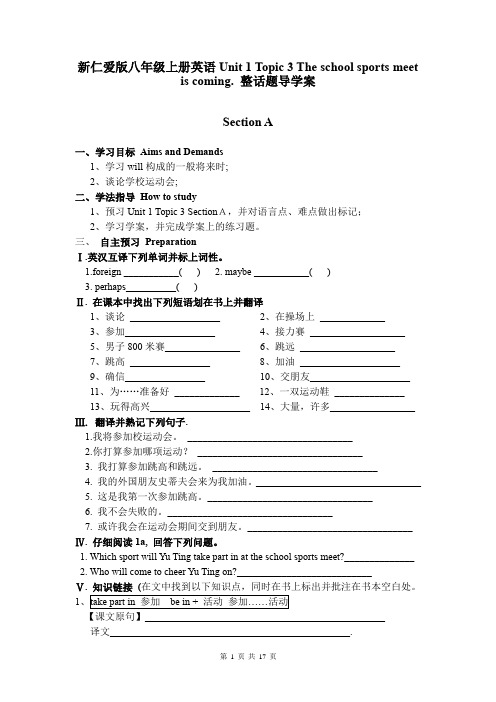
新仁爱版八年级上册英语Unit 1 Topic 3 The school sportsmeetis coming.整话题导学案Section A一、学习目标Aims and Demands1、学习will构成的一般将来时;2、谈论学校运动会;二、学法指导How to study1、预习Unit 1 Topic 3 SectionA,并对语言点、难点做出标记;2、学习学案,并完成学案上的练习题。
三、自主预习PreparationⅠ.英汉互译下列单词并标上词性。
1.foreign ___________( )2. maybe ___________( )3. perhaps__________( )Ⅱ. 在课本中找出下列短语划在书上并翻译1、谈论__________________2、在操场上_____________3、参加__________________4、接力赛___________________5、男子800米赛_______________6、跳远___________________7、跳高________________ 8、加油____________________9、确信________________ 10、交朋友____________________11、为……准备好_____________12、一双运动鞋______________13、玩得高兴____________________ 14、大量,许多_________________ Ⅲ. 翻译并熟记下列句子.1.我将参加校运动会。
_________________________________2.你打算参加哪项运动?_________________________________3. 我打算参加跳高和跳远。
_________________________________4. 我的外国朋友史蒂夫会来为我加油。
仁爱版八年级英语上册 Unit 1 Topic 3 Section A 课件(共28张PPT)
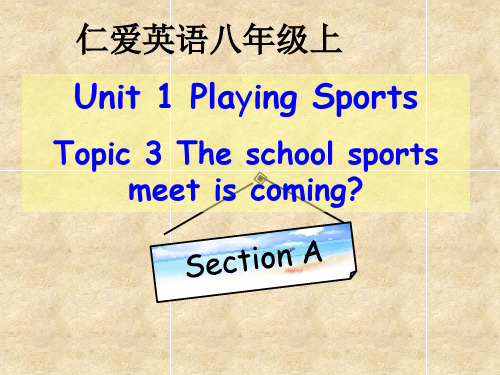
I believe
We learn ♥Expressions of taking part in sports meet:
join in,be in ,take part in、800-meter race ♥ The use of “will”.
TThhee lohnigghjujmumpp
cycling
swimming
basketball
football
running
the long jump the high jump
tennis
A:Which sport do you like best? B:I like… best. A:Why? B:Because …
Li Ming
school sports meet Yu Ting
1.校运动会__sc_h_o_o_l _s_po_r_t_s_m_eet 2.参加 t_a_k_e_p__a_r_t in = j_o_in__i_n_ = __b_e__i_n__
3.男子八百米赛 t_h_e__b_o_y_s’_8_0_0__-m__e_ter race
巧学妙记 一般将来时
一般将来时用法口诀:
一般将来时,将要发生事 谓语不一般,will加动原(动词原形) 要变疑问句,will提前面 否定句,也不难,will后面not添
中奖啦
2分
1
2
1分
1分
4
5
2分 3 3分 6
There will be our school sports meet next month.
仁爱版英语八年级上册UNIT 3 TOPIC 1 Section A 教案
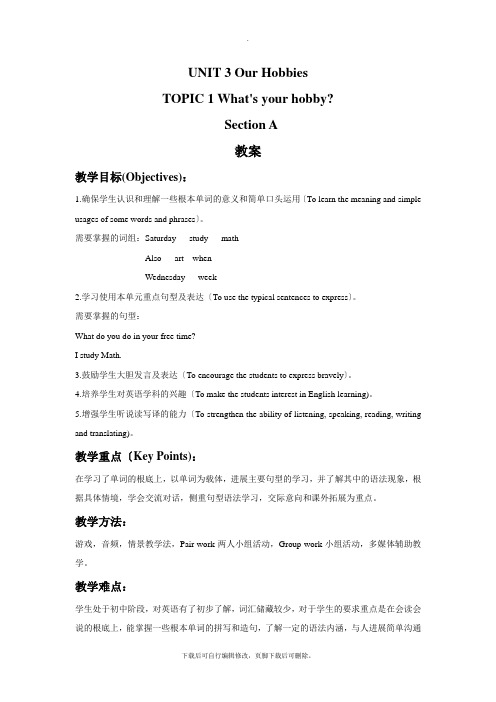
UNIT 3 Our HobbiesTOPIC 1 What's your hobby?Section A教案教学目标(Objectives):1.确保学生认识和理解一些根本单词的意义和简单口头运用〔To learn the meaning and simple usages of some words and phrases〕。
需要掌握的词组:Saturday study mathAlso art whenWednesday week2.学习使用本单元重点句型及表达〔To use the typical sentences to express〕。
需要掌握的句型:What do you do in your free time?I study Math.3.鼓励学生大胆发言及表达〔To encourage the students to express bravely〕。
4.培养学生对英语学科的兴趣〔To make the students interest in English learning)。
5.增强学生听说读写译的能力〔To strengthen the ability of listening, speaking, reading, writing and translating)。
教学重点〔Key Points):在学习了单词的根底上,以单词为载体,进展主要句型的学习,并了解其中的语法现象,根据具体情境,学会交流对话,侧重句型语法学习,交际意向和课外拓展为重点。
教学方法:游戏,音频,情景教学法,Pair-work两人小组活动,Group-work小组活动,多媒体辅助教学。
教学难点:学生处于初中阶段,对英语有了初步了解,词汇储藏较少,对于学生的要求重点是在会读会说的根底上,能掌握一些根本单词的拼写和造句,了解一定的语法内涵,与人进展简单沟通交流。
教学准备:课件、照片素材、音频文件、教学道具。
仁爱版八年级上英语Unit1Topic3The school sports meet is coming .SectionA讲课说课稿

Unit1Topic3The school sports meet is coming .SectionA说课稿英语组:刘丹丹时间:2013年9月11日尊敬的各位老师:今天我说课的内容是仁爱版英语八年级上册Unit1Topic3The school sports meet is coming .SectionA本着变课堂为生活,让学生在情境中快乐学习英语的教学理念,我从以下六方面说本节课。
即说教材,说学习目标,说教法,说学法,说学习流程及说反思。
一.说教材本课是本册书第一单元第三个话题中的第一课,主要围绕运动展开,通过形式多样的对话短文及综合训练活动,用一般将来时谈论自己对运动的喜爱,熟练掌握一般将来时用法。
二.说学习目标 1.知识目标:课标单词exciting,relay race .运用带有will 的句子,表达自己要参加的运动项目。
是本课重点。
2.能力目标:能听说读写有关参加运动会的相关句子。
会写是本课难点。
3.情感目标:能积极与同学合作参与课堂活动,能规范音标发音,培养友好互助的精神。
加强学生热爱运动的意识。
三.说教法提问引入自主学习合作探究四.说学法 1.利用问题解决工具单,预习时有东西可看,课中每个同学都有东西可写。
2.引导学生采用自主,合作,探究的学习方式。
五.说学习流程1. 创设情境,呈现目标理解目标,做到心中有数。
(约1分钟)2.问题引领,自主学习通过预习评价齐读单词及翻译句子或词语,反馈预习情况。
(约8--10分钟)3.合作探究,展示交流解决问题,针对本课重点1a对话,进行大面积操练,首先是输入的过程,自读对话三遍,理解对话,划出重点,并依据工具单提供的重点,以自主合作解决讨论学习“12345”策略并展讲。
老师适时地补充,点拨,评价。
并完成工具单六个问题。
通过齐读,分组读,男女两人读,一个接一个读,换角色读,单位时间内说大量的话,一个接一个任务,抓更多的机会重复,学生不易溜号。
- 1、下载文档前请自行甄别文档内容的完整性,平台不提供额外的编辑、内容补充、找答案等附加服务。
- 2、"仅部分预览"的文档,不可在线预览部分如存在完整性等问题,可反馈申请退款(可完整预览的文档不适用该条件!)。
- 3、如文档侵犯您的权益,请联系客服反馈,我们会尽快为您处理(人工客服工作时间:9:00-18:30)。
八年级上册教案设计Unit 1 Playing SportsTopic 3 The school sports meet is coming.Section AⅠ. Material analysisSection A and Section B 的内容整合,用三个课时上完。
本节课为单元第一课和第二课时,用两课时上完。
主要活动为Section A 的1a和2b。
Section A 对话里,Yu Ting和Li Ming兴奋地谈论即将到来的运动会,呈现了本课所要学的语法重点Future Tense with will。
Yu Ting 和Li Ming 饶有兴趣地围绕Which sport will you take part in? 谈论着各自参加的运动会项目,呈现了重点短语:the boys’ 800-meter race, be in the long jump 等。
本对话呈现了孩子们积极上进的学习生活,要求学生在学会课本语言知识的同时,向Yu Ting 和Li Ming学习,积极参与学校各项集体活动,在培养集体主义思想的同时,培养自己自信、上进的个人素质。
Ⅱ. Teaching aimsKnowledge aims:1. 能正确运用以下短语进行书面表达:the boys’ 800-meter race, be in the long jump, have lots of fun, prepare for,make many fiends, make friends with sb.等。
2. 能正确地理解下列句子和短语:The school sports meet is coming.the coming school sports meet3. 能正确理解并运用will将来时,能运用will进行造句。
Skill aims:1. 能听懂有关运动会项目的名称及相关话题。
2. 能熟练地运用will引导的将来时谈论有关运动会的话题。
3. 能正确朗读介绍运动会项目的对话或文章。
4. 能用will将来时介绍自己或朋友在运动会中参加的项目。
Emotional aims:通过学习Yu Ting 和Li Ming积极上进的对话内容,鼓励学生要积极参与学校集体活动,培养自己乐观、自信、乐于合作的优良品质。
Ⅲ. The key points and difficult pointsKey points:the boys’ 800-meter race, be in the long jump, have lots of fun, prepare for,make many friends, make friends with sb.等短语的理解及运用。
Difficult points:1. be going to和will的不同。
2.The school sports meet is coming.与the coming school sports meet 的正确理解和运用。
Ⅳ. Learning strategies1. 培养学生提前搜集信息的习惯,搜集有关运动会的项目名称。
2. 培养学生善于运用采访收集信息的习惯,愿意就运动会话题进行提问采访。
Ⅴ. Teaching aidsComputer multimedia projector, chalk, blackboard, a flash “Song of Health” (sung by FanXiaoxuan)Everyday saying: All things are easy that are done easily. 做事乐意,诸事容易。
Ⅵ. Teaching proceduresStep InteractionpatternStudent activity Teacher activityIntroduction (7 minutes)1. The wholeclass work2. The wholeclass work3. The wholeclass work4. Six students’work5. Individual workand the wholeclass work6. Some students’work1. Focus their attentionon the teacher.2. Students sing with theflash.3. The whole class readthe passage “My favoritesport ” as quickly as theycan, trying to be the firstsix and get a score of5 points.4. The six winners standat the line and beginto jump. The furthestthree students will getcandies.5. The third student ishappy, the second oneis happier, and thefirst one is the happiest.All the students try tounderstand the differencebetween “exciting”and “excited” with thehelp of the teacher.6. Some volunteers writethe information theyhave collected on theblackboard and theywill be awarded as“super girl” or “superboy”. Other studentslook at the names,trying to guess theircorrespondingChinese names.1. Greet students ready forlearning.2. Play the flash “Song ofHealth” sung by Fan Xiaoxuan.3. Ask the whole class toread their homework asquickly as they can. The firstsix students will stand upand be awarded.4. Lead to 1a. Teacher draws aline on the ground, and thesix winners stand at thesame line and do the longjump to see who are thefurthest three students.5. The teacher gives one candyto the third one, gives twocandies to the second one,and gives three candies tothe first one, introducing“excited” and “exciting”.The teacher says “The jumprace is exciting, and thejumpers are excited.”6. Teacher lets the students towrite the names of sportsactivities on the blackboard,and only asks the students toknow the names but needn’tto remember them.Presentation (10 minutes) 1. The wholeclass work2. The wholeclass work3. The wholeclass work4. The wholeclass work5. Some students’work6. The whole classwork1. Students make sure thatthey understand whatthe statements mean.2. Students try to catchthe general idea of thedialogue and fill inthe blanks.3. Students write downthe missing words,paying more attentionto the causes.4. Students fill theblanks that theyhaven’t finished yet.5. V olunteers write theiranswers on theblackboard, and anotherthree volunteers correctthe answers. All thevolunteers will getscores.6. The whole class checkthe answers togetherwith the teachers.Keys:take part in,800-meter race,long jump,cheer on,exciting1. Teacher introduces thedialogue by saying “Yu Tingand Li Ming are talkingabout the school sports meeton the playground.”, askingthe students to read thestatements in 1b.2. Teacher plays the recordingfor the first time withoutstopping.3. Teacher plays the recordingfor the second time andstops when necessary.4. Teacher lets students scan1a to complete 1b.5. Check 1b. Teacher asksthree students to write theiranswers on the blackboard,then asks another threestudents to correct thewrong parts.6. Teacher checks the answerswhen necessary.Consolidation (10 minutes) 1. The wholeclass work2. The wholeclass work3. Group workand individualwork4. The whole classwork1. V olunteers help theteacher solve theproblems. They will beawarded 5 scores nomatter how they explain,even they may explain inChinese.(1) is coming.Continuous tense hererefers the future tense,which means “willcome quickly”.(2) 800-metre race.(3) will+ do.(4) I believe+objectiveclause.(5) I’m sure+predicativeclause.(6) exciting, excited.2. Students read with therecording twice,trying to follow thespeed.3. Each group choosesthe best pair toperform the dialogue.4. Students do theexercises, guess thefunction of “be goingto ” and “will”.1. Teacher asks somequestions about 1a, lettingthe students help to explain.How to understand thefollowing points?(1) The school sports meetis coming. (is coming?)(2) the boys’ 800-meterrace (800-meter?)(3) I’ll be in the longjump.(will be?)(4) I believe you will win.(I , you ?)(5) I’m sure the sportsmeet will be exciting. (I?)(6) The school sports meet isvery ________, we are all_____.(excite)Teacher addsor correctsthe explanation.2. Teacher plays the recordingwithout stopping twice.3. T eacher organizes the studentsto perform 1a in pairs. Thenthree pairs will do theperformances.4. T eacher shows differencesbetween “be going to do” and“will do” by showing someexercises.Practice (10 minutes) 1. The wholeclass work2. The wholeclass work3. The wholeclass work4. Two students’work5. Group workand pair work6. Pair work1. Students look throughthe exercises in A, thenlisten to the recordingcarefully.2. Students look through theexercise in B, then listento the recording carefullyand fill in the blanks.3. Students listen to therecording and add whatthey have missed.4. Two students writethe answers on theblackboard.5. Students practice thedialogue connecting1a and 2a.6. Each pair has toprepare well with thehelp of each other.1. Teacher asks the studentsto look through A in 3,then plays the recordingwithout stopping.2. Teacher asks the studentsto look through B in 3,then plays the recordingwithout stopping.3. Teacher plays the recordingfor the third time for thestudents to check theiranswers.4. Teacher checks the students’answers, asking twostudents to write theiranswers on the blackboard.Teacher corrects thewrong parts.5. Teacher organizes thestudents to practice 2b inpairs.6. Teacher asks every pair todo the performance.Production (8 minutes) 1. The whole classwork andindividual work2. The whole classwork3. The whole classwork4. Individualwork1. Each student interviewsone student and writesdown a dialogue.2. Students write theirinterview after class,preparing forreporting in the next class.3. Students summarizeSection A with theteacher by doingexercises shown on thescreen.4. Students do the followingtasks:(1) Memorize thesummary after class.(2) Students write theinterview “Whatwill you do in thecoming school sportsmeet?” after class,and prepare forreporting tomorrow.(3) Students learn toread vocabularywith the help ofrecording and thephonetic symbols,and read thedialog after therecording.1. Teacher organizes aninterview according to 4.Students will do it in theirown groups.2. Teacher asks the studentsto write down theirinterview after class.3. Teacher shows thesummary to the students:(1) V ocabulary.(2) the structure: will do.4. Teacher assigns homework:(1) Review the summary ofSection A after class.(2) Report their interviewto the whole class tomorrow.(3) Prepare Section B afterclass.Teaching ReflectionIt’s hard for the students to distinguish the usage of “be going to do” and “will do”. Teacher should design more relevant exercises for the students.Ⅶ. Blackboard designUnit 1 Playing SportsTopic 3 The school sports meet is coming.Section AWhich sport will you take part in? the boys’ 800-meter race I will be in the long jump and the high jump. have lots of funThe school sports meet is coming. make many friendsI’m sure the sports meet will be exciting. make friends with sb.I hope so. prepare for。
